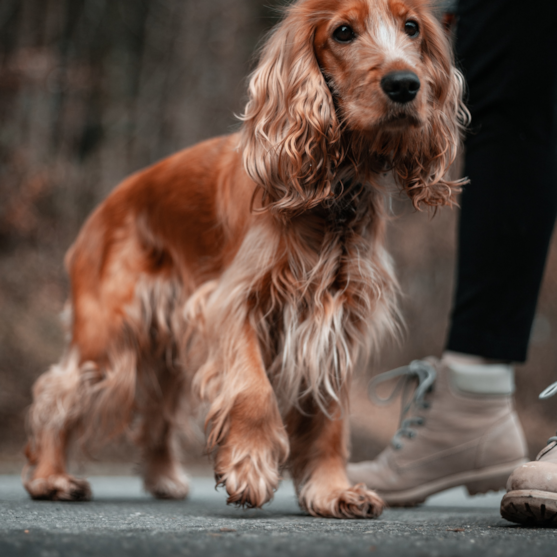

The Cocker Spaniel is a cheerful, affectionate breed known for its soft expression, silky coat, and gentle nature. Originally bred as a hunting dog, the Cocker Spaniel quickly earned a reputation as a loving family companion. With their soulful eyes and ever-wagging tails, they bring warmth and personality to every home.
Cocker Spaniels fit well into a variety of households. They enjoy time with families, respond well to structured routines, and stay happiest when included in daily life. Whether going for a walk, playing in the yard, or relaxing on the couch, they stay close and involved.
This breed’s sweet temperament and manageable size make it a favorite for first-time dog owners, families with kids, and anyone looking for a friendly, easygoing pet.
Characteristics
- Affectionate and people-focused – Cocker Spaniels stay close to their families and enjoy constant interaction. They seek out attention and companionship throughout the day.
- Gentle and well-mannered – Known for their soft temperament, they behave well around children and adapt easily to calm households.
- Smart and responsive – This breed learns quickly and understands commands when training stays clear and consistent.
- Energetic but balanced – Cocker Spaniels enjoy playtime and walks but know how to settle when things quiet down.
- Good with other pets – They typically get along well with other dogs and adjust well to multi-pet households.
- Medium-sized and easy to handle – Most Cocker Spaniels weigh between 20 and 30 pounds, which makes them manageable for a wide range of owners.
- Emotionally aware – These dogs pick up on moods and respond with sensitivity. They stay attuned to the energy in the home.
- Alert but not overly vocal – They may bark when someone approaches the door but rarely become excessive or reactive.
- Adaptable in different settings – Cocker Spaniels adjust to apartment living or life in a larger home, as long as they stay connected to their people.

Appearance
The Cocker Spaniel has a soft, graceful look that matches its gentle nature. This breed carries a well-proportioned, medium-sized frame, with features that blend elegance and athletic ability. Every part of the Cocker Spaniel’s build reflects its history as a sporting dog, from the shape of its body to the way it moves.
Most adult Cocker Spaniels weigh between 20 and 30 pounds and stand 13.5 to 15.5 inches tall at the shoulder. Their body stays compact but solid, with a level topline and a gently sloping chest. Their legs have good bone and support smooth, easy movement that feels natural and balanced.
The coat is one of the breed’s standout features. It grows long and silky, with feathering on the chest, legs, belly, and ears. The texture stays soft and full, with a natural flow that adds to the breed’s refined look. Some coats lie flatter, while others carry a bit of wave, depending on the dog’s individual genetics.
Cocker Spaniels come in a wide range of colors, including solid shades like black, buff, chocolate, and red, as well as various parti-color combinations. Merle and roan patterns also appear in some lines. Their coloring often matches their warm, expressive face, and their big, dark eyes add a softness that draws people in.
The head carries a gentle shape with a slightly rounded skull, a square muzzle, and long, low-set ears that hang close to the cheeks. Their ears are heavily feathered and frame the face in a way that adds to the breed’s sweet and thoughtful expression.
When they move, Cocker Spaniels show a light, flowing gait with good reach and drive. They carry their head proudly and keep their tail level or slightly raised.
Temperament
The Cocker Spaniel has a soft, even-tempered personality that makes it one of the most popular companion breeds. Kind, eager to please, and naturally social, this dog fits easily into family life. It stays close to its people, listens well, and responds with affection in quiet moments and playful ones alike.
This breed forms strong bonds with its household. Cocker Spaniels enjoy being included and often follow their people from room to room. They don’t like being left out of activities and feel most comfortable when they’re part of the daily rhythm. Their loyalty runs deep, and they stay aware of changes in mood or tone.
Cocker Spaniels do well around children, as long as interactions remain calm and respectful. They tolerate gentle play and tend to give clear signals when they need space. Early socialization helps them feel at ease in homes with other dogs or pets, especially when introductions stay gradual and positive.
They enjoy meeting new people and tend to greet guests with curiosity or friendly interest. While they may alert to unfamiliar sounds, they rarely act defensive or aloof. With steady routines and positive experiences, they grow into confident, stable adult dogs who handle new situations with ease.
Their emotional awareness stands out. Cocker Spaniels read the energy around them and adjust their behavior to match. In an active setting, they play and stay lively. In a quiet home, they rest beside their owner without fuss. This flexibility allows them to settle into different lifestyles and bring balance to the home.
Care
Grooming
The Cocker Spaniel has a beautiful, flowing coat that needs regular care to stay clean, healthy, and manageable. While its silky texture and feathered areas add to the breed’s charm, they also require a consistent grooming routine. Without proper upkeep, the coat can tangle, mat, or trap debris close to the skin.
Brushing several times a week is essential. A slicker brush or pin brush works well to remove loose hair and keep the coat smooth. Areas that need extra attention include the ears, legs, chest, and underbelly—places where mats tend to form first. Dogs with thicker or longer coats may benefit from daily brushing, especially if they spend time outdoors.
Professional grooming helps keep the coat at a manageable length. Many owners schedule a full groom every six to eight weeks, which includes trimming the body, feathering, and face. Some prefer a shorter “puppy cut” to reduce upkeep while still maintaining a neat, polished look. Regular trims also keep the coat from picking up dirt and debris on walks.
Bathing every few weeks helps keep the coat soft and clean. Use a gentle dog shampoo that suits the dog’s skin and coat type. After each bath, drying the coat fully—especially around the ears and feathered areas—helps prevent tangles and keeps the dog comfortable.
Ear care is a high priority for this breed. Their long, floppy ears create a warm, moist environment that can lead to infection. Weekly ear checks, followed by gentle cleaning, keep the ears dry and clear of wax or buildup. Many owners also trim the hair around the ear openings to improve airflow.
Nail trimming every three to four weeks keeps the dog’s feet comfortable and prevents joint stress. Overgrown nails affect posture and can lead to long-term problems if left unchecked. A regular check of paw pads and trimming hair between the toes also helps prevent slipping on smooth floors.
The Cocker Spaniel responds well to grooming when handled with calm, steady care. Starting these routines early helps the dog build trust and stay relaxed through brushing, baths, and trims.
Exercise Needs
The Cocker Spaniel enjoys daily activity and thrives on a steady balance of movement and mental engagement. This breed was originally developed as a hunting dog, so it carries a natural drive to explore, stay active, and remain connected to its surroundings.
Most adult Cocker Spaniels do well with 45 to 60 minutes of daily exercise. This can include structured walks, short jogs, or time in a fenced yard. They enjoy games that involve chasing, retrieving, or scent work, which allows them to use their energy and sharp instincts in a productive way.
Walks remain a favorite activity for this breed. A morning and evening stroll help meet their physical needs while giving them a chance to observe the world around them. They respond well to consistent routines and often look forward to the same paths and patterns each day.
Playtime adds variety and helps maintain a positive emotional balance. Cockers enjoy tug toys, squeaky toys, and interactive games with their people. They often invent their own games and stay engaged when the environment includes light challenges or fun distractions.
Mental stimulation is just as important. Puzzle feeders, basic training exercises, and scent-based games keep their minds sharp. This reduces boredom and helps prevent the type of behavior that can come from excess energy or lack of engagement.
Even though they enjoy movement, Cocker Spaniels also know how to rest. After play or a walk, they settle down easily and enjoy relaxing near their people. They don’t need intense workouts to stay healthy, but they do need consistency, variety, and regular interaction.
Health
The Cocker Spaniel is a generally healthy breed, but like all dogs, it has a few specific health considerations that owners should monitor. With regular checkups, a balanced diet, and early attention to signs of discomfort, most Cocker Spaniels enjoy a full and active life.
One area that requires consistent care is the ears. The long, floppy shape limits airflow and holds in moisture, creating an ideal environment for bacteria or yeast. Weekly checks and gentle cleaning help reduce the risk of infection. Redness, odor, or head shaking may signal the need for treatment.
Eye health is another priority. Cocker Spaniels may develop conditions like dry eye or cataracts, particularly as they age. Keeping the eyes clean and scheduling regular vet exams can help detect issues early. Dogs with facial hair around the eyes may also benefit from light trimming to improve visibility and reduce irritation.
Skin sensitivities sometimes appear in this breed. Allergies to food or environmental triggers may cause itching, ear problems, or mild digestive upset. Adjusting the diet or switching grooming products often helps manage these symptoms. A veterinarian may recommend testing or prescription diets if problems persist.
Dental care is important for long-term health. Like many medium-sized breeds, Cocker Spaniels may experience plaque buildup and gum sensitivity. Routine brushing, dental chews, and occasional cleanings by a vet support a healthier mouth and fresher breath.
Joint support also matters, especially as the dog reaches middle age. Maintaining a healthy weight and offering daily movement helps protect the hips and knees. Supplements like glucosamine may be recommended to support joint comfort later in life.
Lifespan
The Cocker Spaniel typically lives between 12 and 15 years, with many reaching their later teens when raised in a steady, well-cared-for environment. Their lifespan reflects the breed’s adaptability, solid structure, and overall good health when attention is given to routine care and lifestyle.
From puppyhood through old age, the Cocker Spaniel stays closely connected to its family. As they grow older, they often remain curious, affectionate, and eager to stay involved in day-to-day life. Though their pace may slow with age, their need for companionship stays the same.
A few key habits support a longer, healthier life. Daily exercise helps maintain muscle tone and joint function. A high-quality diet gives them the nutrients they need to stay sharp and strong. Regular veterinary visits help catch minor changes before they turn into larger problems. And a consistent home routine gives them comfort and structure throughout the years.
As they enter their senior stage, some Cocker Spaniels may rest more or prefer quieter activities, but they still enjoy short walks, gentle play, and time near the people they trust. Adjusting their schedule, offering soft bedding, and being mindful of temperature changes helps them stay comfortable.
Training
The Cocker Spaniel is highly trainable and eager to learn. With a background as a working dog, this breed carries a natural ability to follow direction and stay focused. When paired with a gentle, consistent approach, training becomes an easy and rewarding part of daily life.
Cocker Spaniels respond best to positive reinforcement. Praise, treats, and a calm voice help reinforce good habits and encourage confidence. They stay motivated by interaction, so short, upbeat sessions work well—especially during puppyhood when attention spans are short.
Basic obedience comes easily with structure and repetition. Sit, stay, come, and leash walking often click early on, especially when taught as part of a daily routine. These dogs enjoy pleasing their owners and quickly connect commands to rewards.
House training also tends to go smoothly when consistency stays in place. Scheduled meals and regular outdoor breaks help build reliable bathroom habits. With supervision and patience, most Cocker Spaniels settle into a routine without much resistance.
Socialization is just as important as obedience. Early introductions to other dogs, new people, and different settings help the dog grow into a well-adjusted adult. Cocker Spaniels are naturally friendly, but building early confidence helps reduce the risk of nervousness or separation issues later on.
This breed also enjoys mental stimulation beyond the basics. Learning tricks, solving puzzles, or engaging in scent work adds variety and keeps their minds sharp. Many excel in agility, rally, or therapy work, where their focus and responsiveness shine.
Cocker Spaniels want to connect, follow direction, and stay involved. When training feels like part of a relationship—not just a task—they thrive and grow into respectful, well-mannered companions.
History
The Cocker Spaniel has a long and well-documented history that traces back to Spain and the United Kingdom, where spaniels were bred as hunting dogs for flushing and retrieving game birds. The name “Cocker” comes from their early use in hunting woodcock, a type of game bird that the breed excelled at locating and flushing from dense cover.
Spaniels were originally grouped by size and hunting style rather than by formal breed. In the 19th century, as dog shows became more popular and breed standards were introduced, the Cocker Spaniel began to emerge as a distinct type within the spaniel group. Breeders focused on refining its size, structure, and temperament to suit both hunting work and family life.
By the early 20th century, the breed had split into two lines—the English Cocker Spaniel and the American Cocker Spaniel. The English version retained a more field-oriented build and slightly longer head, while the American line developed a rounder skull, shorter muzzle, and more heavily feathered coat. Both breeds share the same roots but have evolved in slightly different directions based on purpose and appearance.
The American Kennel Club (AKC) officially recognized the American Cocker Spaniel in 1878, and by the mid-1900s, it had become one of the most popular dog breeds in the United States. Its compact size, sweet temperament, and elegant appearance helped it transition from a field dog to a beloved family pet.
Today, the Cocker Spaniel remains a favorite across the world. Both English and American varieties are cherished for their companionship, versatility, and classic spaniel charm. Whether in the field, the show ring, or the home, the breed continues to reflect a long tradition of loyalty, intelligence, and gentle spirit.
